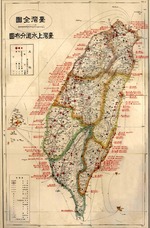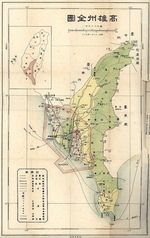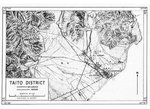Taiwan
| Alliance | Axis - Minor Member Nation or Possession | |
| Possessing Power | Japan | |
| Entry into WW2 | 7 Jul 1937 | |
| Population in 1939 | 5,500,000 | |
| Military Deaths in WW2 | 30,304 |
Contributor: C. Peter Chen
ww2dbaseTaiwan, also referred to as "Formosa" by Westerners during this period (from Portuguese Ilha Formosa, the name given by 16th Century Portuguese explorers), had been a Japanese colony since the Treaty of Shimonoseki was signed on 17 Apr 1895 at the end of the First Sino-Japanese War. Resistance against Japanese occupation was heavy at first, but by 1902 most of the Chinese resistance groups were wiped out. Various uprisings took place in the following years, but Japanese policy was able to calm a significant portion of the Chinese population. Remaining resistance groups were generally held under control by skillful political manipulation that directed hostility of these groups against one another, away from the Japanese administration. In general, the virtual dictatorship under the rule of Tokyo-appointed Governor Generals developed Taiwan as a model colony, which was Japan's first. Taiwan's infrastructure was the initial main focus, followed by the development of agriculture so that Taiwan could export sugar and rice to Japan's growing population. In the mid-1930s, a limited democracy was introduced, again toward the goal of establishing a model colony. Around this time, Taiwan was also allowed to develop its industry to feed the needs of the growing Japanese military. When the Second Sino-Japanese War erupted in Jul 1937, the efforts to assimilate the local society into the Japanese population were stepped up. To that end, in 1940, the colonial government encouraged parents to give their children Japanese names; the parents were often rewarded with increased rations and other benefits. In 1942 schools were desegregated so that Chinese and aborigine children would be taught together by Japanese teachers. Also in 1942, Chinese and aborigine men in Taiwan were encouraged to enlist in the Japanese military; they were similarly rewarded by increased rations. According to statistics from the Japanese Ministry of Health, Labor, and Welfare, 207,183 Taiwanese served in the Japanese military between 1937 and 1945, and 30,304 of them were killed or missing in action. By 1944, due to Japanese efforts, Taiwan enjoyed the second highest enrollment rate for elementary school-aged children, trailing behind only Japan. While punishment for insurgency had always been dealt with harshly and swiftly, during the war years brutal punishment was given for any sign of disobedience. Large numbers of women from Taiwan were recruited as Comfort Women during the war, which still causes political tension between the Republic of China and Japan today.
ww2dbaseBoth the Japanese Army and the Japanese Navy developed Taiwan from a military sense. The Japanese Army's nascent jungle warfare training center was located in Taiwan shortly before the outbreak of the Pacific War. The ports of Keelung (Kirun or Kiirun in Japanese) and Takau (Takao in Japanese, now renamed Kaohsiung in Mandarin Chinese) were originally developed by the Japanese into major commercial ports but by this time were also served as main naval bases; at the opening chapters of the war, many of the amphibious missions against British Malaya and Philippine Islands were launched from these two ports. The Japanese Army and Navy airfields on the island also attracted American bombing especially during the American invasion of the Philippine Islands and Okinawa, Japan.
ww2dbaseWhen the war ended in 1945, Taiwan's agricultural output fell to 49% of 1937 levels, industrial output fell to 66%, coal production fell from 200,000 metric tons to 15,000, and electricity production fell from 320 kilowatts to 30; this was largely caused by Allied bombing.
ww2dbaseAfter the Japanese surrender, Taiwan was formally returned to Republic of China control on 25 Oct 1945, ending 50 years of Japanese occupation. There were about 309,000 Japanese living in Taiwan in 1938; nearly all were deported back to Japan after the 1945 surrender. 173 Taiwanese members of the Japanese military were found guilty of war crimes; 26 of them were given death sentences. Of the 30,304 Taiwanese killed during the war while serving in the Japanese military, at least 26,000 of them were enshrined at Yasukuni in Tokyo, Japan.
ww2dbaseAdministrative Divisions Under Japanese Occupation & Gazetteer
ww2dbaseTaiwan was annexed by Japan prior to the outbreak of WW2. It was divided into eight prefectures (five shu and three cho, both of which were translated as "prefecture" in English). Because Taiwan was Chinese prior to 1895, Japanese between 1895 and 1945, and Chinese once again after 1945, some names of places had changed. To the westerner, the changes were even greater for that those names that had not changed in the written language had changed in pronunciation (ie. Japanese reading vs. Chinese reading of the same Kanji/Hanzi characters). Thus, the following could also serve as a gazetteer as a cross referencing aid.
| Japanese Name | Prefecture Type | Chinese Name (Postal Map/Pinyin) | Japanese Pop. | Chinese & Aboriginal Pop. | Korean Pop. | Other Pop. | Total Pop. | |
|---|---|---|---|---|---|---|---|---|
| 1 | Taihoku | Sho | Taipei/Taibei | 153,928 | 1,053,372 | 1,051 | 25,531 | 1,233,882 |
| 2 | Shinchiku | Sho | Hsinchu/Xinzhu | 20,693 | 815,274 | 150 | 1,894 | 838,011 |
| 3 | Taichu | Sho | Taichung/Taizhong | 46,371 | 1,329,620 | 333 | 3,863 | 1,380,187 |
| 4 | Tainan | Sho | Tainan/Tainan | 53,446 | 1,489,621 | 253 | 7,375 | 1,550,695 |
| 5 | Takao | Sho | Kaohsiung/Gaoxiong | 59,633 | 863,313 | 598 | 6,839 | 930,383 |
| 6 | Karenko | Cho | Hualien/Hualian | 20,914 | 130,720 | 119 | 2,032 | 153,785 |
| 7 | Taito | Cho | Taitung/Taidong | 7,078 | 85,068 | 35 | 957 | 93,138 |
| 8 | Hoko | Cho | Penghu/Penghu | 3,619 | 65,694 | 0 | 74 | 69,387 |
ww2dbaseThe above population figures came from the Showa 16 (1941) census. The total population was 6,249.468, which showed a marked growth from 1939, which was about 5,500,000.
ww2dbaseThe prefectures were each broken up into cities, subprefectures, and districts in the second tier of each administrative division. Some of the major ones are as follows.
| Japanese Name | Parent Prefecture | Division Type | Chinese Name (Postal Map/Pinyin) |
|---|---|---|---|
| Taihoku | Taihoku | City | Taipei/Taibei |
| Kirun | Taihoku | City | Keelung/Jilong |
| Giran | Taihoku | City | Yilan/Yilan |
| Shinchiku | Shinchiku | City | Hsinchu/Xinzhu |
| Taichu | Taichu | City | Taitung/Taidong |
| Shoka | Taichu | City | Changhua/Zhanghua |
| Tainan | Tainan | City | Tainan/Tainan |
| Kagi | Tainan | City | Chiayi/Jiayi |
| Takao | Takao | City | Kaohsiung/Gaoxiong |
| Heito | Takao | City | Pingtung/Pingdong |
| Karenko | Karenko | City | Hualien/Hualian |
| Hoko | Mako | Subprefecture | Magong/Magong |
| Moan | Mako | Subprefecture | Wang'an/Wang'an |
ww2dbasePartial list of smaller localities:
- Tamsui: A district in Taihoku City, Taihoku Prefecture during occupation; now Tamsui District, New Taipei City.
- Suo: A town in Giran City, Taihoku Prefecture during occupation; now Su'ao Township, Yilan County.
- Matsuyama: A village in Taihoku Prefecture during occupation, but was incorporated into Taihoku City in 1938; now Songshan District and Xinyi District, Taipei City.
- Toen: A district in Shinchiku Prefecture during occupation; now Taoyuan City.
- Toyohara: A district in Taichu Prefecture during occupation; now Fengyuan District, Taichung County.
- Hokuto: A district in Shoka City, Taichu Prefecture during occupation; now Beidou Township, Changhua County.
- Nanto: A district in Taichu Prefecture during occupation; now Nantou City, Nantou County.
- Niitaka: A district in Taichu Prefecture during occupation, encompassed the highest peak in Taiwan, which lent its name to one of the coded messages leading up to the Pearl Harbor strike; now broken up to Jiji, Shuili, Yuchi, and Xinyi Townships, Nantou County.
- Ujitsu: A village in Daiton District, Taichu City, Taichu Prefecture during occupation; now Wuri District, Taichung County.
- Hozan: A district in Takao Prefecture during occupation; now Fengshan District, Kaohsiung City.
- Okayama: A district in Takao Prefecture during occupation; now Gangshan District and Qiaotou District, Kaohsiung City.
- Toko: A district in Heito City, Takao Prefecture during occupation; now Donggang Township, Pingtung County.
- Koshun: A town in Heito City, Takao Prefecture during occupation; now Hengchun Township, Pingtung County.
ww2dbaseRelocation of the Republic of China to Taiwan
ww2dbaseIn Mar 1946, the Chinese Civil War restarted in mainland China, which ultimately ended in a Communist victory. The Republic of China withdrew to Taiwan on 10 Dec 1949. The Nationalists were able to transfer quantities of gold reserves and various cultural treasures to Taiwan before they could be captured by the Communists. The Republic of China still remains in Taiwan today with the capital in the city of Taipei; mainland China today is occupied by a new country established by the victorious Communist forces.
ww2dbaseRelated Article: History of the Republic of China on the Chinese Mainland
ww2dbaseSource: Wikipedia
Last Major Update: Mar 2012
| People | ||
| Attun, Palalin | Lin, Hsiung-cheng | Xie, Jieshi |
| Koo, Hsien-Jung | Tam, Kim-sui | |
| Lan, Gaochuan | Tsia, Bun-tat | |
| Events Taken Place in Taiwan | ||
| Philippines Campaign, Phase 1, the Leyte Campaign | 22 Oct 1944 - 21 Dec 1944 | |
| Philippines Campaign, Phase 2 | 12 Dec 1944 - 15 Aug 1945 | |
| Raid into the South China Sea | 10 Jan 1945 - 20 Jan 1945 | |
| Japan's Surrender | 14 Aug 1945 - 2 Sep 1945 | |
| Facilities | ||
| Giran Airfield | Air Base | |
| Heito Airfield | Air Base | |
| Hokuto Airfield | Air Base | |
| Hozan Airfield | Air Base | |
| Kagi Airfield | Air Base | |
| Karenko Airfield | Air Base | |
| Koryu Airfield | Air Base | |
| Koshun Airfield | Air Base | |
| Mako Guard District | Navy Base | |
| Matsuyama Airfield | Air Base | |
| Okayama Aircraft Factory | Air Base, Factory | |
| Reigaryo Airfield | Air Base | |
| Shinchiku Airfield | Air Base | |
| Shoka Airfield | Air Base | |
| Soton Airfield | Air Base | |
| Taichu Airfield | Air Base | |
| Taichu West Airfield | Air Base | |
| Taihoku General Government Building | Government Building | |
| Taihoku Prison | Prison Camp | |
| Taihoku Prisoner of War Camp No 6 | Prison Camp | |
| Takao Guard District | Navy Base | |
| Takao Seaplane Base | Air Base | |
| Tamsui Seaplane Base | Air Base | |
Photographs
 |  |  |  |
 |  |  |  |
Taiwan in World War II Interactive Map
Please consider supporting us on Patreon. Even $1 per month will go a long way! Thank you. Please help us spread the word: Stay updated with WW2DB: |
Visitor Submitted Comments
9 Jun 2016 03:40:27 PM
Thank you.
I found the information here very helpful.
I am researching the history of Taiwan and Japan as it relates to my family history.
11 Apr 2018 11:02:32 AM
Cheers, Now I know my origins
15 Apr 2018 11:27:57 AM
Seriously do you think the ancestors saw the easy way out,; dieing as being honourable. That thinking is why Japan lost the War in such an ignominious defeate. What would the ancestors think of the deaths of 3 to 10 million and 6 million Chinese, deaths perpetrated by Japan, was this honorable. Rape of Nanking ring a bell? Gen Patton quote "No poor bastard ever won a war by dying for his country. He won it by making other bastards die for their country."
30 Mar 2020 03:08:19 PM
Taiwanese are absolutely scum. To think they enlisted to the *** army and killed their fellow Chinese.
20 Mar 2022 11:07:51 AM
Yue Long Yip:
War sucks for everyone.
Taiwan occupied by Japan and forced to align with Japan in WWII.
China is currently abusive and oppressive to Taiwan. Leave Taiwan alone, China. Hands off, Communists.
25 Mar 2022 03:20:42 AM
Your article states that (1) the War ended in 1945. That is a very serious error. The War did not end in 1945. The surrender ceremonies in 1945 marked the end of hostilities, not the end of the War. The end of the War is when the peace settlement (peace treaty) comes into force. For WWII in the Pacific that is 1952.
(2) "After the Japanese surrender, Taiwan was formally returned to Republic of China control on 25 Oct 1945, ending 50 years of Japanese occupation." Taiwan was not RETURNED to the Rep. of China. The Oct. 25, 1945, surrender ceremonies mark the beginning of the military occupation. Notably, military occupation does not transfer sovereignty.
(3) The Japanese era in Taiwan was not an "occupation." The 1895 treaty specified a transfer of territorial sovereignty, hence Taiwan became part of Japan's national territory.
21 Feb 2024 09:57:38 PM
The Japanese government’s “comfort women” investigation report shows:
(1) On November 4, 1938, Taiwan sent 300 comfort women to the southern branch through the Taiwan Governor's Office. It was implemented on November 8, 1938. Each team of 10-30 women would be led by the employer and board the Kaohsiung fixed ship in Taiwan. Flight to destination (Relationship Information List of the Ministry of Internal Affairs and Police Agency of Japan).
The statistics of the number of people crossing to China from Formosa are as follows (data from the Japanese Ministry of Foreign Affairs’ public relations report)
Total: North China 77, Shanghai 247, South China 618 (Time: 1939.1.11-1942.8.18)
(2) Go to Borneo. 50 plus 20 = 70 girls (Japanese Defense Agency relationship information 1942.3.12-6.13)
(3) 49 Taiwanese, Fu Group Headquarters - 25th Army (stationed in Singapore) 1942.8.25 (Japanese Defense Agency relationship information)
(4) The number of comfort women confirmed by Taiwan’s private sector: 18 in Taiwan, 5 in the Guangzhou Pearl River Delta, 17 in Hainan Island, 12 in the Philippines, 6 in Myanmar, 2 in Andaman, India, 13 in Indonesia, and 2 in Okinawa. Five served in two countries. (Investigation period 1992-1997)
28 Jun 2024 04:29:30 PM
I'm not sure what purpose Yvonne's post about a government's own investigation into it's own war crimes serves, but if people are looking to gain a through knowledge of sexual slavery of the Japanese military in regards to Taiwanese women, please search up "The Comfort Women Controversy - Lessons from Taiwan" by Thomas J. Ward and the works cited section of that article.
All visitor submitted comments are opinions of those making the submissions and do not reflect views of WW2DB.

- » Wreck of Teruzuki Found (27 Jul 2025)
- » USS Orlean's Bow Found (22 Jul 2025)
- » The Emperor of Japan Planned to Honor WW2-era Japanese POWs in Mongolia (4 Jul 2025)
- » US State Lawmaker John Winter Caught Using Racial Slur "Jap" and Apologized (11 Jun 2025)
- » US Government Plans to Purge WW2 Information (17 Mar 2025)
- » See all news
- » 1,182 biographies
- » 337 events
- » 45,119 timeline entries
- » 1,249 ships
- » 350 aircraft models
- » 207 vehicle models
- » 376 weapon models
- » 123 historical documents
- » 261 facilities
- » 470 book reviews
- » 28,412 photos
- » 365 maps
Winston Churchill, on the RAF
Please consider supporting us on Patreon. Even $1 a month will go a long way. Thank you!
Or, please support us by purchasing some WW2DB merchandise at TeeSpring, Thank you!
4 Jun 2015 09:18:36 AM
Those Taiwanese soldiers are cowards if not traitors. They may be forced or fooled to join *** army. They had chance to turn the weapons against the *** . Some are traitors that joined *** army willingly like 李登輝. They shamed their ancestors.